The Digital Nomad life has really taken off in recent years. The COVID pandemic has shown people and companies alike that the days of old in an office are no longer necessary to get things done. The world is your office now and it awaits you. I’ve been to many different places now to practice the Digital nomad lifestyle and below is a list of my favorite places in the world.

Europe is home to a variety of amazing cities and towns that are perfect for the remote working lifestyle. A number of countries in Europe have even recently started issuing digital nomad specific visas that will allow remote workers to stay for extended periods of time well beyond that of a normal tourist visa.
While you might not have the incredible tropical views of a place like Bali, Europe offers an incredible wide array of destinations ranging from big cities, to cute villages, to islands off the coast of Africa. This list will include some of my favorite places in Europe to be a digital nomad.

What makes a good city for digital nomads?
There are certain attributes that make a city suitable for a digital nomad. Essentially, it should offer a healthy work-life balance while offering plenty of excitement during your stay. Here are the main attributes that make a city an attractive option for digital nomads: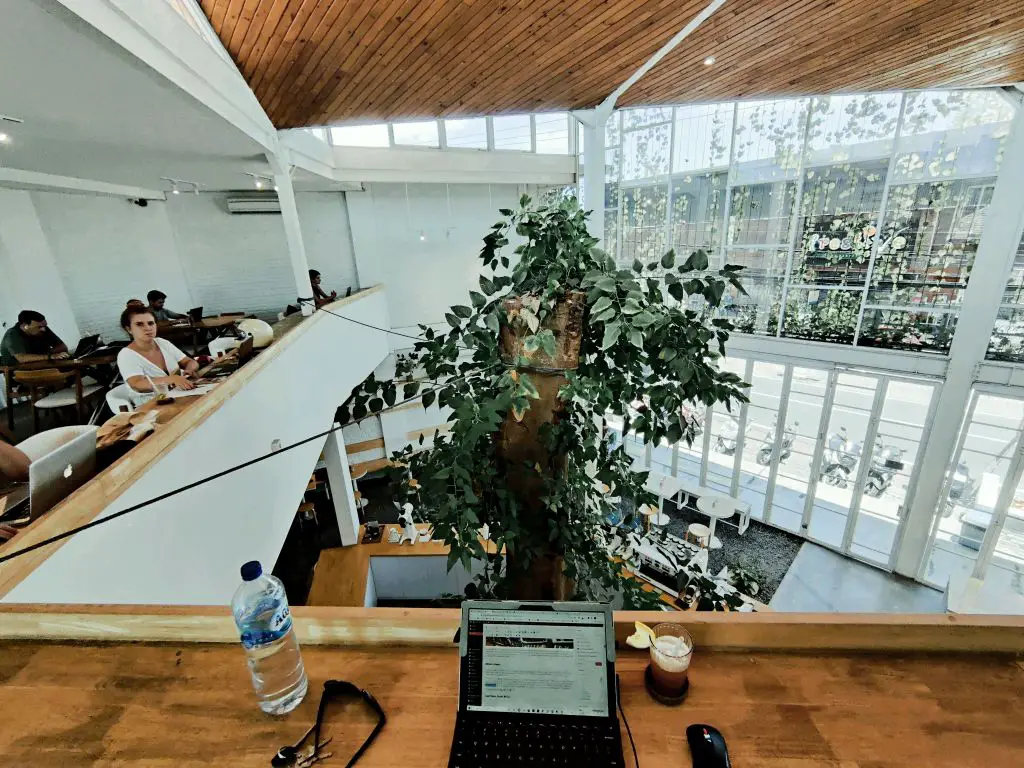
Cost of living & accommodation
A solid mix of housing or accommodation options as well as a low cost of living is one of the most important factors for digital nomads looking to spend time in a city. The availability of flexible short-term rentals is a big plus-point for any city as it presents more accommodations for those looking to adopt a digital nomad lifestyle.
Internet speed & infrastructure
Internet speed and infrastructure is probably the most important thing a digital nomad looks for. What makes it important is that it is entirely out of your control. Thankfully, most big cities have great wireless infrastructure in the modern times. I love traveling to places to discover that the internet and mobile connection is magnitudes better than “developed nations” and substantially cheaper.
Even if WIFI connections are bad, mobile 4G networks have become strong enough where hotspotting is also an option. This was an absolute must in Zanzibar where the WIFI was god awful.
Amenities
From medical centers and tourist information hubs to parks, beaches, pubs, restaurants, cultural landmarks, and beyond, a city’s sights as well as its amenities are vital to its status as a digital nomad-friendly city (these are the things that make a city worth visiting, after all).
Community
Digital nomads are independent but social creatures. The fact that you want to leave your home and just travel to unknown destinations speaks to your personality. However, we are all human and crave human interaction to some degree. Therefore, the community of the city is important as it will dictate how easy it is to make new friends.
Most digital nomad places nowadays have large groups and meetups that make it very easy to meet like minded individuals. This is not just for socializing either as a strong community means you can network and create ideas easier than ever before.
Time Zone
For the modern remote worker, your location is everything. One of the most important things to consider is your time zone. Are you working a job that is tied to US hours? Then living in Bali, Indonesia might be tough because you will be 12-13 hours ahead of the US east coast.
This means you will be burning the midnight oil which is fine if that’s what you’re into (and many of the coworking spaces in Bali are open 24/7) but this gets quite taxing after awhile. Your social life and ability to meet people might suffer as most people will enjoy the day time hours.
If your job is not time zone sensitive, aka you work for yourself or you work a job without many meetings at certain times, then the world is your oyster!
Visa requirements
Your ability to enter a country and stay in that country for the amount of time you want is incredibly important to consider. Most countries on my list have easy visa requirements. Either they issue visas on arrival or there are no visa requirements at all. There’s nothing more annoying than applying for a visa beforehand.
The next thing to consider is the length of the visa. Most countries I’ve been to issue visas that are 90 days and below. Some countries will allow you to extend this for a fee while other countries will allow you to just leave and re-enter (also called a visa run). Other countries like Georgia issue you a visa for a year. Personally, 90 days are a decent amount of time for me to spend somewhere as I like to move around mix it up. However, if you value a slower pace of life, you’ll want to dig into the extended visa options of that country (if any).
Because of COVID, many countries around the world have acknowledged the digital nomad revolution and are making it easier for digital nomads to obtain longer stay visas. Many countries around the EU are issuing digital nomad visas which will allow you to stay beyond the 90 day limit currently imposed. However, the requirements for many of these visas might be out of reach for many.
For example, the Greece digital nomad visa requires you to show proof of earning at least 3,000 Euros a month which might be higher than many people.
Beach vs City?
Another very important criteria you should consider is whether you want a beach destination or a city. Many people have a fantasy of working from the beach with views of the ocean while sipping coconuts. This is definitely one of my favorite things to do so I am certainly not against it.
However, if you’re planning to stay many months or even a year in such a place, you might get bored after awhile. I’m not saying after a month, but potentially after 3 months you’ll crave city life and may be hard pressed to find it.
There are a few gems of digital nomad locations like Bali that perfectly blend both of these two things together.
Tax implications for digital nomads
If you’re planning to be a digital nomad, it’s advisable to familiarize yourself with the tax implications of such a remote working arrangement with your country of origin and your destination country.
As I am American, I must report worldwide income no matter where I earn it. This responsibility usually doesn’t apply to those in most other countries.
Some countries will require you to report taxable income if you’re a digital nomad but most countries will waive this responsibility if you are staying for under 6 months. Many other countries have also issued digital nomad visas where you will not have to worry about the tax implications. Make sure to research this ahead of time so you don’t get surprised!
Americans and the FEIE deduction
If you’re American and planning to work remotely around the world, consider yourself lucky as you are eligible for the FEIE deduction. This deduction essentially states that you can deduct up to $112k a year (this value goes up every year depending on inflation) from your taxes meaning if you make under $112k a year, you will pay $0 in taxes to the IRS.
Better still, if you are working a conventional salaried job in the US but are able to freely travel and work around the world, you can use this deduction to get a lot of money back. This is because a conventional salaried job means your taxes are automatically withheld with each paycheck. With this deduction, you essentially get back all those taxes you’ve paid throughout the year.
I go into great detail in my post about the FEIE deduction if you also want to save money (hint: just move abroad).
Lisbon, Portugal
Lisbon has quickly become the digital nomad hotspot in Europe. Flocks of digital nomads from Europe and America have made Lisbon their (temporary) homes. It’s not hard to see why. Lisbon is a beautiful European capital with an incredible amount of history and beautiful traditional architecture.

It’s located on the Atlantic ocean and enjoys a temperate climate year round with plenty of sun and the absence of extreme weather on both ends. The cost of living is cheap by European standards (although this is going up quickly) and you can live very well for much less than comparable cities in the US for example.
Lisbon is blessed with a booming startup scene, amazing restaurants, co-working spaces, delicious wine, vibrant nightlife, and friendly people. You are also in the middle of Portugal where you can travel easily around the country. Make sure to read my Portugal travel itinerary to plan your trip.
Lisbon, Portugal Facts
- Avg. Cost of Living Per Month: $1,900-2,500
- Internet Speed: Fast
- Visa Length + Price: 90 day visa, digital nomad visa possible.
- Highlights: Perfect combination of sunny weather, beautiful architecture, and a vibrant digital nomad scene
- Downsides: Lisbon has become much more expensive in recent years due to the influx of foreign investment and digital nomads.
- Rating: 4.3/5
Tenerife, Spain
Tenerife has quickly become Spain’s digital nomad hotspot. While Barcelona, Madrid, or Valencia would be the typical go to digital nomad cities, many people have flocked to the islands for a more scenic work location.
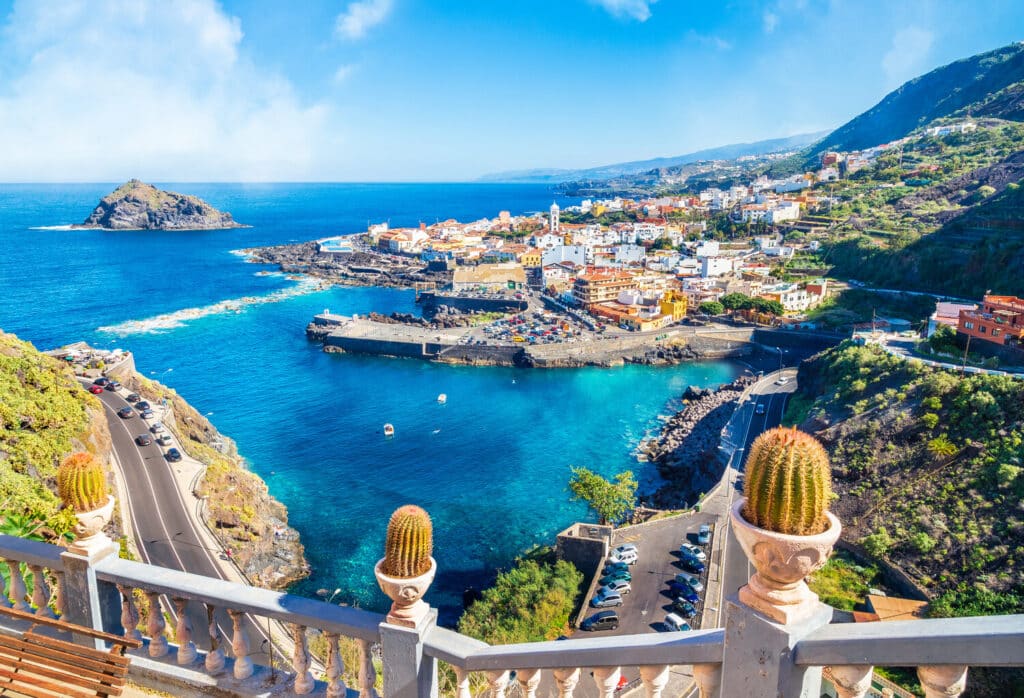
Tenerife offers all of that and then some. Not only is it equipped with some of the most dramatic views you can find, but you’ll also find a vibrant cafe culture, great Spanish cuisine, lots of digital nomad groups, and a cheaper cost of living versus the big cities. Tenerife is a bit hard to get to and once you’re there, you are not close to much besides the other islands. However, if you’re keen for island life away from everything, this is definitely the place for you.
Athens, Greece
Greece is probably my favorite country in Europe and Athens is the capital city and de-facto digital nomad destination of choice for me in Greece. Many people are team Thessaloniki which I have also visited but I prefer the capital more. Athens is a very vibrant city full of history, culture, and beautiful views.

It’s not the most established digital nomad city in Europe. There are not as many co-working spaces in Athens as other cities in Europe but this is quickly changing. Delicious Greek food, great weather, and friendly people are what will draw people to Athens in the future. Also, Athens is the hub for ferries to the Greek islands which are absolutely beautiful. I wouldn’t mind working for some time in a beautiful island like Sifnos but you’ll need to pay more money and there isn’t much going on there unless you know people (but so beautiful nonetheless).
Athens is also quite cheap as a big city. You can find decent apartments in the city center for affordable prices. Wine and food are generally very affordable by Western standards.
Athens, Greece Facts
- Cost of Living Per Month (1 person): $1,200 – $1,600
- WIFI/Mobile: 8/10
- Visa Length + Price: 90 day visitor visa, Schengen rules apply
- Highlights: Historic city with plenty of amazing restaurants, cafes, and lower cost of living. Close proximity to beautiful Greek islands
- Downsides: Not the most beautiful city center as far as European cities go
Plovdiv, Bulgaria
Bulgaria in recent years has quickly become one of the favorites for digital nomads and in the know travelers that want an authentic European experience for a lower price. I spent a few weeks traveling through Bulgaria and was really surprised by what I found. The capital of Sofia is a vibrant city with a booming digital nomad scene, plenty of nice cocktail bars, cafes, restaurants, and the likes. It’s also much cheaper than other European countries while offering the same beautiful architectural wonders and infrastructure.

Plovdiv is the second biggest city in the country but is more beautiful in my opinion. It does not have the same big city vibe as Sofia but by no means is it small. The old town is beautiful and has plenty to do for long term residents. There are many cafes, coworking spaces and a vibrant community of remote workers. Plovdiv is also cheaper than Sofia and closer to the Black Sea for those that crave a seaside break.
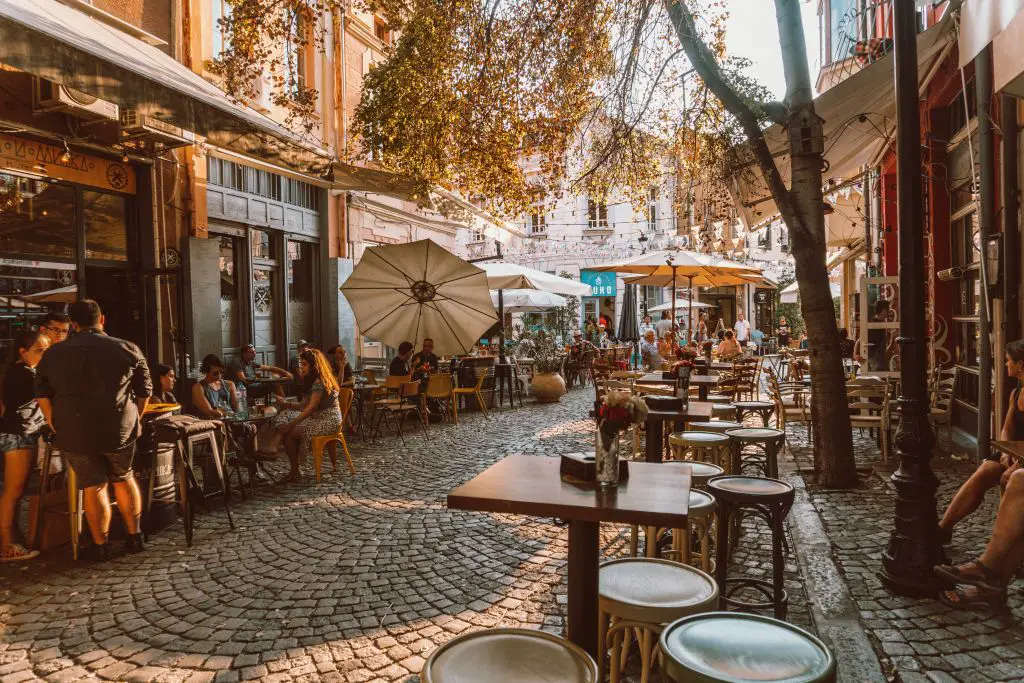
Overall, I think Bulgaria is a fantastic option in Europe for those looking for a European experience without the high costs.
Plovdiv, Bulgaria Facts
- Cost of Living Per Month (1 person): $1,400 – $1,700
- WIFI/Mobile: 9/10
- Visa Length + Price: 90 day visitor visa
- Highlights: Very beautiful and vibrant city with low cost of living .
- Downsides: Not a true big city and could get boring after awhile
Naples, Italy
Italy is home to countless amazing cities and towns that I can’t even begin to list all my favorites. However, for digital nomads, I would prefer to stay in the cities as this gives you more options for entertainment when the work day is over. While places like the Amalfi coast and the beaches of Puglia are incredibly beautiful, there’s just not much to do after a few weeks.

Italy has quickly become an attractive destination for digital nomads. The offerings of the country needs no introduction as everyone and their mothers have already visited Italy in some capacity.
For my favorite remote working cities in Italy, Naples is definitely one I would give a thumbs up to. Naples is home to a very vibrant remote working scene as it is chalk full of cafes, co-working spaces and more. Naples is also much cheaper in comparison to other cities like Rome, Florence, or Milan. Given that it is a University town, you’ll find plenty of great deals on accommodations near the city center for a very cheap price.

If that wasn’t enough, Naples is the birthplace of pizza after all and the Napoli style pizza is in my opinion, the most superior form of pizza. You’ll find delicious pizza for 6-8 Euros and Aperol spritz for as cheap as 1 Euro. Naples is by all intents and purposes the most casual and laid back big city of Italy. It’s not as beautiful by any means but its charm lies within the chaos. It’s not a city for everyone, but I’ve had an amazing experience each time I’ve visited.
Naples is also close to the Amalfi coast, Capri, Matera, and more making it easy to get out and explore Italy on the weekends.
Naples, Italy Facts
- Cost of Living Per Month (1 person): $1,400 – $1,800
- WIFI/Mobile: 8/10
- Visa Length + Price: 90 day visa for non EU residents
- Highlights: Amazing food, cheap cost of living, proximity to other beautiful places in the region
- Downsides: Not as beautiful as other Italian cities
Cyclades Islands, Greece
The Cyclades island chain in Greece is one of my favorite places in the world. I absolutely adore the islands that are filled with their iconic white houses with blue doors. There is something special about these islands that is hard to explain until you’ve really spent quality time there.

I’ve traveled extensively through the Cyclades visiting over a dozen islands and it’s never ceased to amaze me. It’s not your typical digital nomad destination because these islands are generally sparsely populated without much to do and is entirely geared to tourists. To spend time working remote in these islands takes a certain type of traveler that is okay being without too much social interaction and wants to just appreciate the beautiful Mediterranean views.
Tallinn, Estonia
The Baltic countries have quickly become a tech haven and digital nomad hotspot. Tallinn in Estonia is probably the best proposition among the other capitals of Riga and Vilnius.
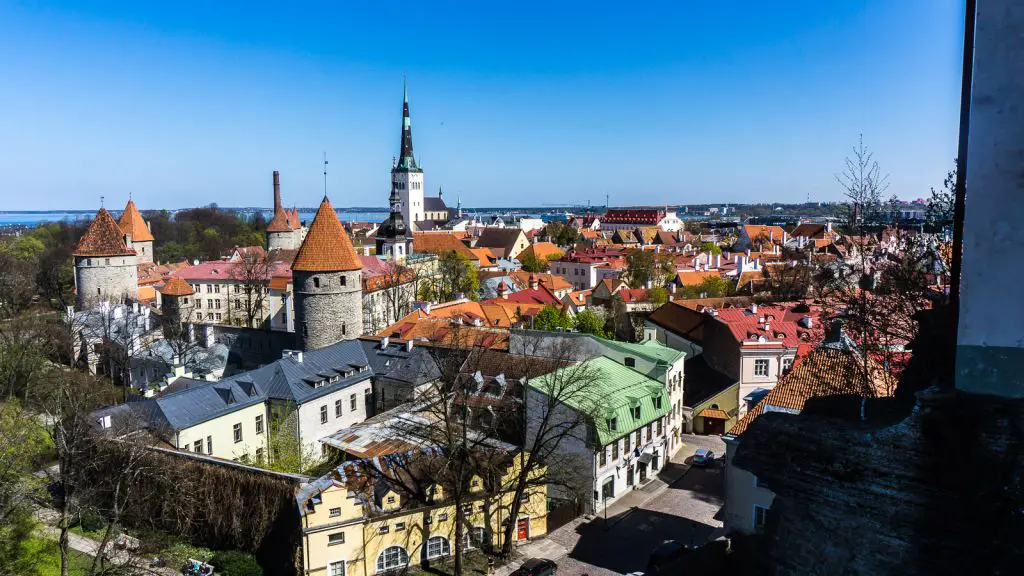
Tallinn is a beautiful European capital with picturesque buildings, cobblestone streets, and a vibrant digital nomad scene. Tallinn in recent years has digitalized rapidly and was one of the first countries in the world to offer a digital nomad style visa, long before the COVID pandemic.
Tallinn is chalk full of cafes, co-working spaces, craft beer bars, and more. It offers a relatively low cost of living for EU standards although this is quickly increasing due to inflation and the increase in digital nomads.
Budva, Montenegro
Montenegro is an incredibly beautiful country in the Balkans that is often overlooked as a tourist destination by most. Most travelers visit Croatia but Montenegro offers the same beautiful coastline and architectural wonders at a lower price.

I spent a week road tripping through this small Mediterranean country and I think it is definitely worth the visit for remote workers.
While most guides recommend the capital city of Podgorica for digital nomads, I was not so impressed. The city is not that beautiful in my opinion and doesn’t compare to cities like Belgrade or even Sarajevo. I think the most special part of Montenegro is definitely by the coast.
Budva and Kotor are my favorites in Montenegro. While I think Kotor offers a more beautiful view and coastline, Budva is a bigger city and would be more interesting for someone staying long term.
Lagos, Portugal
Portugal is the capital of digital nomads in Europe with Lisbon quickly becoming overrun with remote workers. Therefore, if you want to get away from Lisbon, I would recommend going south to the Algarve coast. This beautiful coastline is filled with incredible beaches, a more laid back vibe, and cheaper prices.

Lagos is the biggest city in the Algarve with plenty to do. There are many cafes, restaurants, bars, and the like in this seaside town. You can also find much cheaper apartments than in Lisbon although these prices are also increasing steadily.
I would avoid coming here during July and August given that it is the peak season for tourists.
Split, Croatia
Croatia is a country that needs no introduction. Its beautiful coastline has welcomed travelers for centuries and in recent years has become one of the premier tourist destinations in Europe. Dubrovnik is probably one of the busiest and most famous cities in the world now after Game of Thrones rocketed the city to worldwide fame.
In recent years, Croatia has also been home to more and more digital nomads. As of 2021, Croatia offers a digital nomad visa that allows one to stay for six to twelve months without much issue. There are many cities in Croatia that are suitable for digital nomads but Split has been the hotspot in recent years. This coastal city has developed into one of the most cosmopolitan cities in the country with an abundance of beautiful cafes, seaside restaurants, and coworking spaces.
Split offers a solid cost of living with cheap long term accommodations available near the city center. Croatia is not as cheap as other countries in this list but you can easily live a very good life in Split.
Istanbul, Turkey
Istanbul is a city that I’ve returned to time and time again. Located between Europe and Asia, Istanbul is an incredibly historic city with beautiful mosques, architecture, and culture. Better still, it has a low cost of living that has been expedited due to its currency collapse in recent years.

Turkish food is absolutely delicious and you have a world class dining scene in Istanbul. Literally that’s one of the reasons I keep coming back to this beautiful city. Istanbul is not nearly as cheap as other cities within Turkey due to its cosmopolitan appeal but it is definitely the place you’ll want to spend your time in.
There are an abundance of cafes and coworking spaces in Istanbul but the amount of decent gyms is really lacking.
Istanbul, Turkey Facts
- Cost of Living Per Month (1 person): $1,500 – $1,800
- WIFI/Mobile: 8/10
- Visa Length + Price: 90 day visitor visa, Visa runs are possible
- Highlights: Very cosmopolitan city with incredible food, history, and nightlife
- Downsides: Traffic and overcrowding (15m people live in Istanbul)
Tbilisi, Georgia
The Georgian capital of Tbilisi has quickly become the digital nomad hotspot of Europe. I spent a few weeks in Tbilisi and it’s not hard to see why.
Tbilisi offers the most bang for the buck of any city I’ve ever been to. In fact, it’s quite shocking how cheap a city like Tbilisi can be given how developed it is. Tbilisi offers countless restaurants, cafes, co-working spaces, and a plethora of high quality gyms. Tbilisi is also a city littered with history and beautiful viewpoints from the old town. Georgian food is also delicious with plenty of high quality meats, khinkali, and of course the famed khatchapuri.
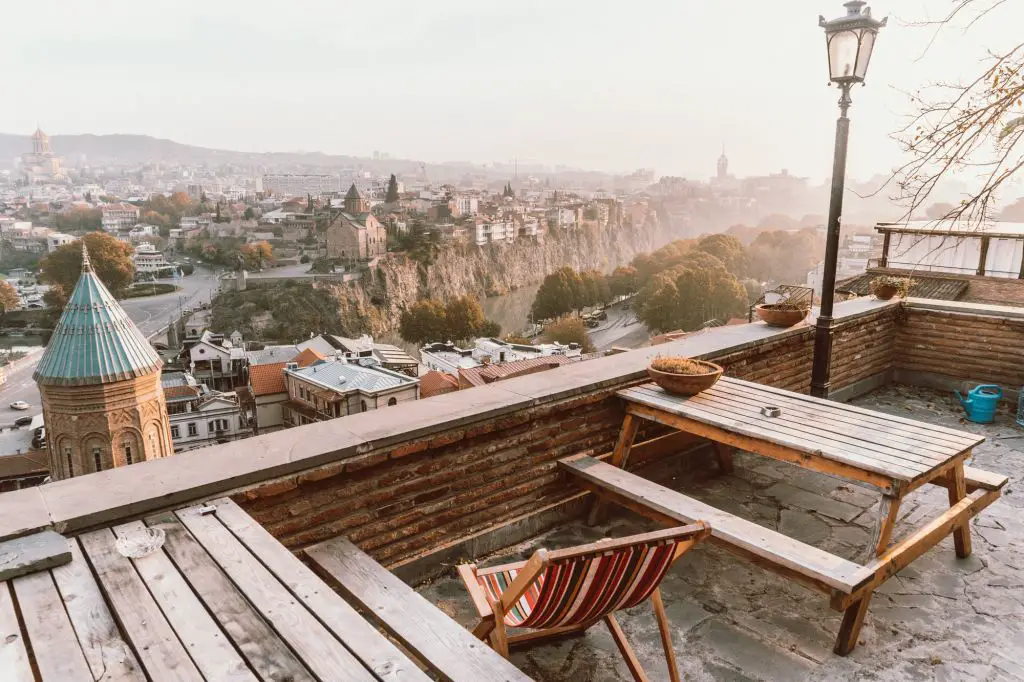
Within Georgia, you can take easy trips to the mountains or the wine country which is absolutely beautiful. You can even make quick trips to Armenia or Azerbaijan.
Tbilisi, Georgia Facts
- Avg. Cost of Living Per Month: $1,000 – $1,200
- Internet Speed: 10/10
- Visa Length + Price: 1 year visa, easily extendable.
- Highlights: Incredible value for money, great food, large nomad community
- Downsides: Cold winters and hot summers
Belgrade, Serbia
Belgrade is my ultimate sleeper city for digital nomads in Europe. The capital of Serbia is perhaps the most vibrant of the capitals of the Balkan countries. In recent years, Belgrade has really seen a huge boom in development with many coworking spaces, cafes, breweries and the likes being opened. Belgrade even has a few ultra high end gyms that I never found in other cities in the Balkans.
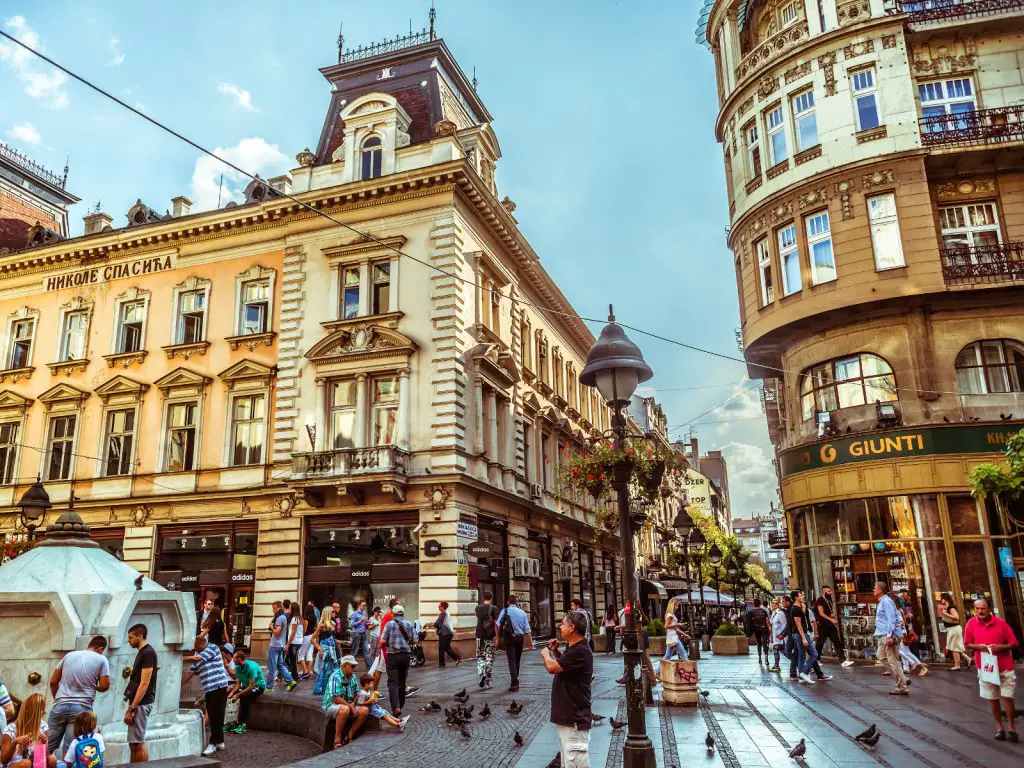
Belgrade itself is beautiful with plenty of Gothic style buildings, cobblestone streets, and your typical European amenities. Serbia is not an EU country and the prices here are generally cheaper than its neighbors like Croatia. Rents in the city are very affordable in comparison to other European capitals.
Belgrade also has an energy to it that I didn’t experience in other Balkan capitals.
Belgrade, Serbia Facts
- Cost of Living Per Month (1 person): $1,200 – $1,400
- WIFI/Mobile: 8/10
- Visa Length + Price: 90 day visitor visa, Visa runs are possible
- Highlights: Beautiful city with great food, nightlife, and cafes.
- Downsides: Bringing enough USD/Euro cash to get the best exchange rates
The world is your oyster
Hopefully this list will inspire you to take your digital nomad adventures to the next level! If you have other destinations great for digital nomads, please comment accordingly!







